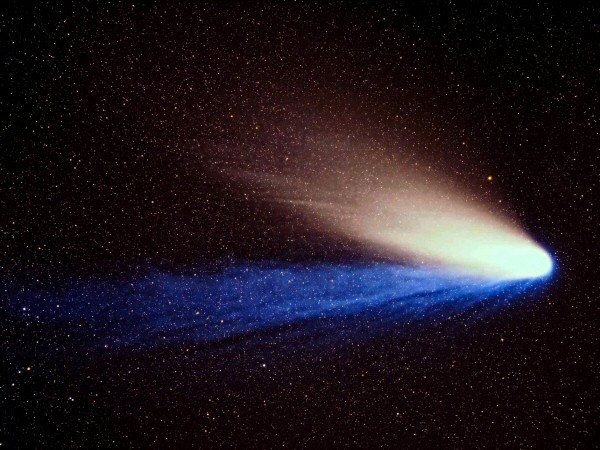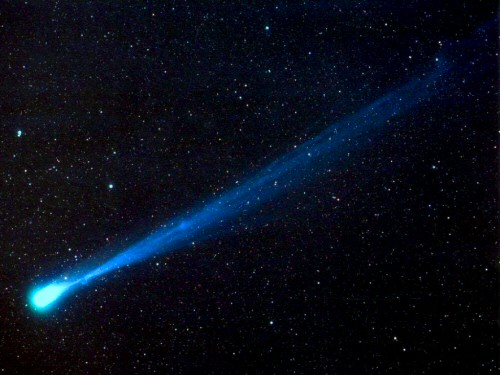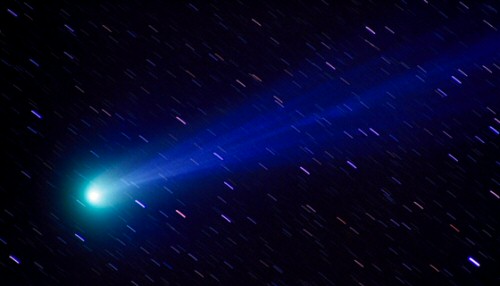Comets
Comets are icy objects with characteristically highly elliptical orbits, and follow direct motion paths around the Sun, as do the planets and asteroids (except a few such as Halley's Comet, which has a retrograde orbit).

Comet Hale-Bopp (1997), which possessed two distinct tails - a dust tail
(white) and an ion tail (blue)
Structure
The structure of comets is very simple. The model accepted today is known as the Whipple model, and was first proposed in 1951 by Fred L. Whipple.
![]() Nucleus:
a dirty snowball averaging around 1 km in diameter; the only solid
part of a comet.
Nucleus:
a dirty snowball averaging around 1 km in diameter; the only solid
part of a comet.
![]() Coma:
a large transparent cloud of gas and dust surounding the nucleus. Like tails,
comas only form once the nucleus is within a certain proximity to the Sun.
Coma:
a large transparent cloud of gas and dust surounding the nucleus. Like tails,
comas only form once the nucleus is within a certain proximity to the Sun.
![]() Tail:
tails of gas and dust directed away from the Sun. Dust tails and ion (or
plasma) tails are known. Can be 1 million km wide and up to 10 million km
in length. The shape and direction of the tails are defined by interaction
with the solar wind and radiation pressure.
Tail:
tails of gas and dust directed away from the Sun. Dust tails and ion (or
plasma) tails are known. Can be 1 million km wide and up to 10 million km
in length. The shape and direction of the tails are defined by interaction
with the solar wind and radiation pressure.
Orbital classification
Comets can be divided into two classes based upon their orbital periods :-
![]() Short-period:
orbital periods less than 200 years, orbit almost entirely within the planetary
system
Short-period:
orbital periods less than 200 years, orbit almost entirely within the planetary
system
![]() Long-period:
orbital periods greater than 200 years, and nearly perfect parabolic orbits
Long-period:
orbital periods greater than 200 years, and nearly perfect parabolic orbits
As a group, short-period comets possess the following characteristics :-
| Average inclination | Average eccentricity |
|---|---|
| 11° | 0.56 |

Comet Hyakutake (1996)
Formation
There are two theories on where comets originate. The first describes how comets may have originally formed early in the Solar System's existence at similar distances from the Sun as Saturn and Neptune. They would then have been ejected from the main planetary system out to the Oort Cloud, perhaps having been perturbed by the planets. In this theory, there is a finite resource of potential comets in the Oort Cloud which is being depleted.
The second theory relies on the passage of the Solar System through interstellar clouds of gas and dust. The gravity of the Sun disturbs the material and forces it to accrete, forming fresh cometary nuclei. Thus, the number of icy bodies that may become comets is occasionally refreshed.
The Oort cloud
This is also known as the Öpik-Oort cloud. Ernst Öpik proposed in 1932 that a cometary reservoir lay at great distances from the Sun. A similar idea was put forward in 1950 by J. H. Oort, who refined the idea by suggesting that the objects originated following an icy planet's disintegration early in the Solar System's history. The remaining bodies were then influenced by the gravitational fields of the gas giants (particularly Jupiter's), and redirected towards the inner Solar System, ejected out of the Solar System entirely, or forced into extremely long-period orbits. This final group constitutes the Oort cloud. (Kaufmann, 1994; Illingworth, 1994)
This is the region in which long-period comets spend most of their lifetimes. Such comets have aphelia of 5 to 50 AU and perihelia of 30 000 to 100 000 AU. Vast distances such as these become very important when one considers that the closest star to the Sun, Proxima Centauri, lies at a distance of 270 000 AU from the Sun. Therefore, stars passing the Solar System may perturb the orbits of Oort cloud objects, causing them to either overcome the Sun's gravitational hold upon them and leave the Solar System, or be directed in towards the Sun. (Kaufmann, 1994; Illingworth, 1994)

A closer shot of Comet Hyakutake (1996)
Missions to comets
Giotto was sent to study Halley's Comet in 1986 and Comet P/Grigg-Skjellerup in 1990. It was launched on 2nd July 1985. It has passed Earth twice during its lifetime, once on 2nd July 1990 (the first time a spacecraft used the Earth for a gravity-assist manoeuvre), and the second time on 1st July 1999.
A more recent and far more ambitious mission, Rosetta, has been planned by the European Space Agency (ESA). It will visit Comet 46P/Wirtanen, and consists of both an orbiter and a lander. The orbiter spacecraft will be approximately 32m across, with solar panels large enough for it to operate at distances of over 450 million miles from the Sun. It will travel around 5.25 billion miles over a period of 8 years before reaching Wirtanen, and then deploy the lander.
Other missions :-
![]() ICE (International
Cometary Explorer): Comet P/Giacobini-Zinner, 1985; Halley's Comet, 1986
ICE (International
Cometary Explorer): Comet P/Giacobini-Zinner, 1985; Halley's Comet, 1986
![]() Suisei: Halley's
Comet, 1986
Suisei: Halley's
Comet, 1986
![]() Sakigake:
Halley's Comet, 1986
Sakigake:
Halley's Comet, 1986
![]() Vega 1 and
Vega 2: Halley's Comet, 1986
Vega 1 and
Vega 2: Halley's Comet, 1986
![]() Deep
Space 1: Comets Wilson-Harrington and Borrelly, 2001
Deep
Space 1: Comets Wilson-Harrington and Borrelly, 2001
![]() Stardust:
Comet 81P/Wild-2, 2004
Stardust:
Comet 81P/Wild-2, 2004

Pictured above is Comet Shoemaker-Levy 9, an unusual comet. Discovered
in 1993, it had been torn apart following a close encounter with Jupiter
a year before.
The fragments collided with Jupiter a year later, over a period of a week
from 16th to 23rd July 1994. This false-colour close-up
view was captured by the Hubble Space Telescope's WFPC2 (Wide Field Planetary
Camera 2).